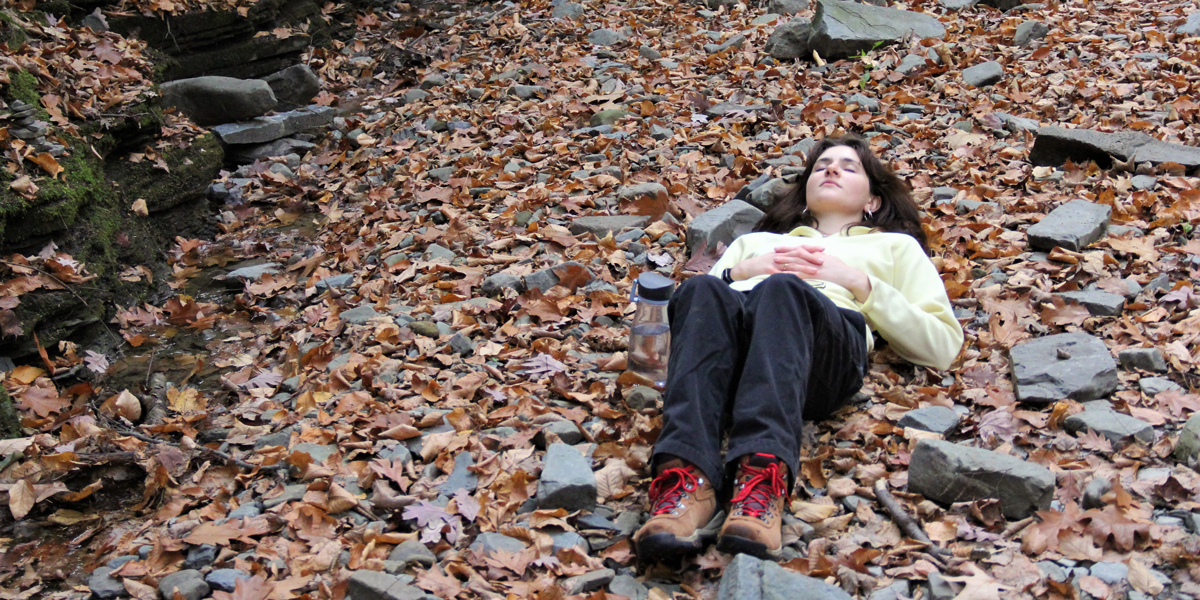OUT 177: Hiking students alleviate academic stress with forest bathing

At the end of a brisk autumn trek through the IBM Glen, adjunct instructor Elias Miller encouraged students in his OUT 177: Hiking class to sit in silence for five minutes. Having chatted all the way along the trail, the students seemed unsure at first. Then, they began to spread out; they sat at the edge of the creek, laid on piles of fallen leaves and leaned against trees. When five minutes was up, the group reconvened with a look of something like wonder on their faces.
Miller devised this five-minute exercise as an introduction to the art of forest bathing. Otherwise known as shinrin-yoku, forest bathing is a Japanese meditation technique that relaxes the mind through natural immersion. Originally invented as an antidote for over-stressed office workers, the deliberate slowness of forest bathing offers a respite from fast-paced modern life. Its effects are most pronounced when full attention is given to the process — phones should be disconnected and conversations put on hold.
Miller encouraged his students to focus on the five senses if they noticed their minds wandering toward homework. By absorbing the sounds, smells and sights of the forest, the mind diverts its focus from stressful thoughts. After five minutes was up, the students discussed what they noticed about their surroundings: squirrels clambering up birch trees, leaves ruffling in the wind, creek water murmuring over rocks. For those five minutes, they completely forgot about the obligations of academic life.
Hiking is a physical practice that strengthens the body, but Miller believes it can strengthen the mind in equal measure. After noticing students’ positive reactions to greenery, he began to build mini-meditation sessions into his classes.
“Spending time in nature is really healthy for students. Being mindful and present makes a big difference, and they might not get that chance in their daily lives,” Miller said. “Giving students an opportunity to step away from their work lets them see the value of their work.”
Phoebe Paul, a senior studying human development, noticed the exercise changed her mindset.
“After pushing yourself physically, the forest puts you in a different headspace. It’s easy to let your mind drift, and your thoughts are more positive afterwards,” she said.
Paul takes Miller’s hiking class on Fridays and uses these meditation sessions as a mental transition from a busy work week to a restful weekend. She thinks all kinds of people can benefit from practicing forest bathing, not just hikers.
“I definitely think everyone should try it. People from all different majors, all walks of life, can get a new perspective,” she said.
The benefits of forest bathing extend far beyond simple relaxation. Spending time in the natural world has a litany of powerful, scientifically-proven effects on the human brain. If we spend the majority of our days inside, we begin to crave exposure to nature. Having a house plant in a room has been shown to bring relief in enclosed spaces, but it’s no substitute for the real thing. Breathing fresh air can lower heart rates and reduce the risk of airborne illness. Exposure to natural sunlight improves our circadian rhythms and sleep quality. Being in nature or looking at pictures of nature can reduce anger, fear and stress while increasing positive feelings.
All of these benefits are available to anyone willing to try — the best part about forest bathing is the simplicity of the practice. Chloe Monks, also a senior studying human development, sees forest bathing as a more achievable way to build meditation into her life.
“I’ve always aspired to be a daily meditator,” she said. “But it’s definitely easier to do in the forest. In my daily life there’s a lot of noise, but in the forest you just hear the water, the birds, the leaves rustling.”
No matter how busy your schedule is, forest bathing is an attainable practice. It can be done on lunch breaks, in the early morning or before bedtime. It doesn’t cost anything, except five minutes. You don’t even need access to a forest: once you understand the basic technique, you can practice in any area with natural features. Walk slowly, sit or lay down. Focus on how your body feels and how it fits into its surroundings. You’ll return to daily life with a greater appreciation for your place in the natural order of things.
“I was holding a leaf while meditating and I was able to connect to the wind, the sun and the trees,” Monks said. “When I could see everything affecting the leaf, I could see how it affected me.”
For more information about how Binghamton University encourages well-being in the classroom, visit the Healthy Campus Initiative: B-Healthy webpage.
OUT 177: Hiking is a credit-based course with Outdoor Pursuits, a program area under Campus Recreation. Learn more about Campus Recreation’s programs and services by visiting the website, play.binghamton.edu.
